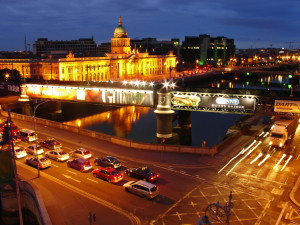 In 2003 the Republic of Ireland was about to begin its second boom in less than ten years. The Original Celtic Tiger had seen the Republic shift from being one of the poorest countries in Western Europe to one of the most prosperous. This boom had largely been based on trade exports and was helped considerably by an influx of large US companies into Ireland, such as Dell, Intel and Google. By the beginning of the “noughties” this unprecedented growth had slowed considerably, and Ireland looked to be facing a period of economic decline. However, the construction sector in Ireland was about to fuel a second, unsustainable and eventually catastrophic boom.
In 2003 the Republic of Ireland was about to begin its second boom in less than ten years. The Original Celtic Tiger had seen the Republic shift from being one of the poorest countries in Western Europe to one of the most prosperous. This boom had largely been based on trade exports and was helped considerably by an influx of large US companies into Ireland, such as Dell, Intel and Google. By the beginning of the “noughties” this unprecedented growth had slowed considerably, and Ireland looked to be facing a period of economic decline. However, the construction sector in Ireland was about to fuel a second, unsustainable and eventually catastrophic boom.
The Celtic Tiger led to mass immigration in Ireland as workers from across Europe, particularly new EU member states, came flooding into the country. They were joined by the Irish diaspora, who were beginning to return to the Republic as the feel-good factor and job opportunities lured them back from their travels. Houses were being built at a phenomenal rate – circa 75,000 a year from 2000 onwards – and Ireland’s economy began to rely very heavily on the construction industry. By the end of 2006 the construction sector made up circa 25% of Ireland’s GDP and also accounted for 12% of the total workforce.
House prices rose dramatically during this period, more than doubling in many cases. Landowners were offered huge sums of money by developers who were assured of homebuyers queuing up to buy their houses. The homebuyers were safe in the knowledge that the banks would give them a mortgage, many borrowing 100% or more of the property value. Due to the rapidly rising house prices, banks appeared to have minimal credit risk since as soon as they lent on a property its value increased. Of course, as predicted by few and listened to by even fewer, the bubble eventually burst.
The property market collapsed in 2008, having slowed to a standstill the year before. The effects on the Irish banking system and construction industries were catastrophic, and this quickly flowed through the whole economy. By the end of 2012 the construction industry made up less than 6% of Ireland’s GDP and less than 5% of the workforce.
Like the rest of the country, the Irish tax system had been overly reliant on the construction industry – and the property crash hit the Government hard. A combination of a fall in revenues and having to bail out the banks led to the beginning of what is likely to be years of fiscal corrections for the Irish people.
Irish unemployment rates since the crash have increased dramatically. In 2006 there were less than 100k people unemployed; at June 2012 this figure had more than tripled. The backlash by the people of Ireland led to a change of government in 2011: Fianna Fail members, who had been in power throughout the booms and subsequent bust, were heavily defeated. Fine Gael and the Labour party formed a coalition government.
In a complete reversal of 10 years ago, Ireland is now enduring mass emigration as many foreign workers are leaving and young Irish people are looking overseas for employment opportunities. In 2003 there were 60,000 immigrants, double the number of emigrants. By 2012 the number of emigrants was 87,000 – outstripping immigrants by over 20,000.
There are, however, signs that Ireland is recovering. Property prices have steadied and even risen in some areas, and unemployment rates have also fallen. Ireland’s food and farming sectors have started to prosper, with economies in the Far East looking to invest. The banking sector has also shown signs of recovery with recent debt raises being oversubscribed.
One surprise good news story involves former rogue trader Nick Leeson. Now a Galway resident, Mr. Leeson is a principal at GDP Partnership, which provides restructuring, corporate finance and asset management advice to small businesses and individuals. After serving a prison sentence and also beating cancer, Mr. Leeson now draws on his past adversities to help Irish borrowers deal with their bank problems.

